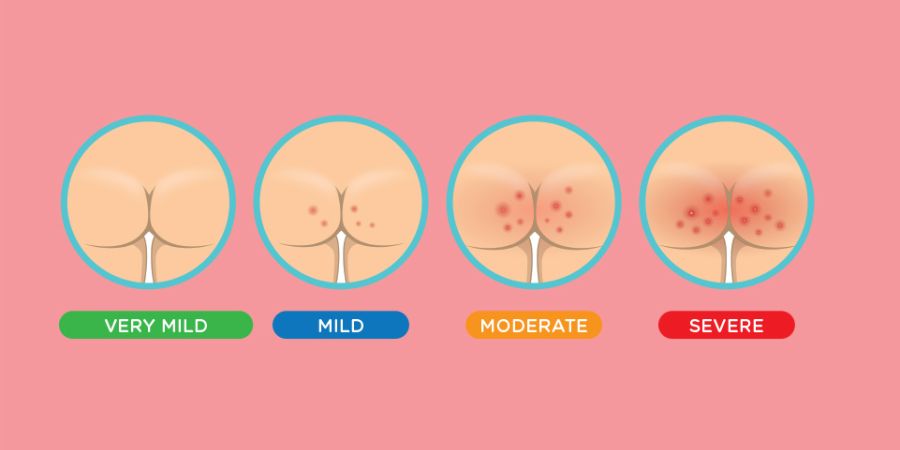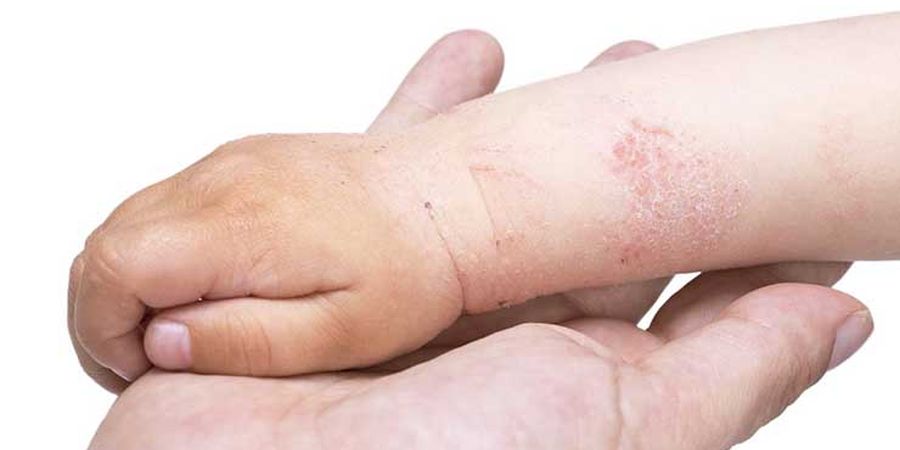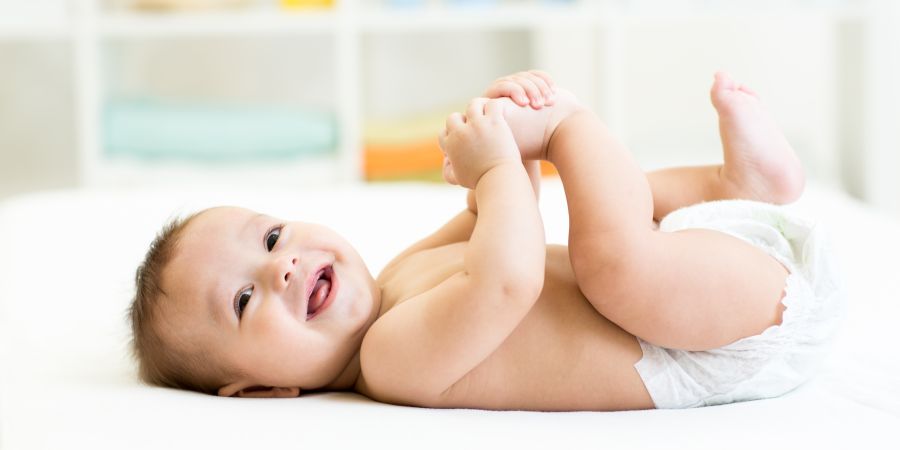Learn the best ways to prevent baby rashes and what steps you can follow to remedy them fast
Table of contents:
How to prevent and treat heat rash.
Diaper rash causes and treatment.
How to sooth Cradle Cap.
Finding a good eczema rash solution.
Other common rashes and their treatment.
Do what you can for your baby’s skin.
No one likes to see their little one with an uncomfortable, itchy skin condition. Unfortunately, there are a host of baby rashes that can affect your child.
Rashes may be the result of many things different things. It could be due to genetic factors or something present in their environment. Even detergents and lotions can cause skin irritation in children. Did you know that changes in temperature could cause a flair up?
The reason for this is baby’s skin is actually dramatically different from an adults. Their skin is more permeable, and can absorb and lose moisture more readily.
As well, the top layer of a infant’s skin (the epidermis) isn’t totally attached to the layer below (the dermis), like in adult skin.
Because of these factors, a baby’s skin can absorb everything that is put on it, very easily. Many baby products on the market today actually contain harmful hormone disrupting chemicals or known allergens.
Unknowingly, parents can be making their child’s skin irritation worse, by applying creams or lotions with ingredients that are harmful or only safe for adults.
It is important to determine what kind of rash your baby has so the right treatment can be given. General face and body rashes, baby heat rash and diaper rash are all different types of rashes your child may be suffering from and there are various ways these conditions can be caused and treated.
Let’s take a look at the different types of rashes and how they can be caused, treated and prevented.
Heat rash baby: Prevention and Treatment

A heat rash shows up as patches of small red or pink bumps that look visibly irritated. You may even see some of these bumps as small blisters with fluid inside.
It can be crop up just about anywhere, but particularly where the skin is covered by clothes. It can also be found in the folds and creases of your baby’s skin, such as around the neck, the armpits or groin.
A heat rash is caused by a baby’s sensitive skin getting too hot. The sweat clogs the sweat glands and causes skin irritation and pimple like bumps. It can happen when the weather is warm and is most frequently in the summer.
Sometimes heat rash can even be caused by well-meaning parents who overdress their infants. Because of this, heat rashes can also happen in the winter when a baby is wearing too many tight layers.
You might notice your baby is irritated or uncomfortable or trying to scratch their skin. It’s important to treat a heat rash quickly as scratching and bleeding can leave the skin open to infection.
Most cases of heat rash should clear up on their own. But you can help healing along with a few steps:
- Because the rash is moist, keep your baby’s skin as dry as possible. Let them dry with a light fan or air dry as opposed to a towel that might irritate their skin further.
- Let your baby be naked whenever possible. This will allow air to circulate around the skin and prevent clothing from further irritating their skin.
- Avoid heavy lotions or oils as this will only further clog their pores.
This type of rash can be prevented by making sure your baby is dressed in clothing appropriate for the weather.
Even in winter, an infant doesn’t need more clothing than an adult despite how their hands and feet may feel.
In the summer they should have cool, breathable, lose clothing and be dressed in as few layers or tight clothes as possible.
If it is extra hot, let them sleep with a low fan in the room, and don’t overdo it with blankets and pajamas. The best temperature for a baby to sleep in is between 65-70 degrees.
Their skin should be able to breathe as much as possible in the summer, so avoid tights and other uncomfortable clothing. Having a cutely dress child comes second to their comfort.
Diaper Rash Causes and Treatment

A diaper rash is another type of skin rash that can affect all children from newborns to toddlers. Most often, though, it affects babies between 9-12 months old. This is because they are sitting a lot and tend to be in a wet diaper more often.
The diaper rash is fairly easy to diagnose because it is under the diaper and occurs in places where the diaper is in close contact with the skin. The skin will look red and inflamed and might affect their bum and/or genital area as well as the folds of skin near their legs where the diaper sits. Your baby’s skin might be warm to the touch in these areas.
There are a number of possible causes of diaper rash:
- The most common reason is wetness. But even the most attentive parent who changes diapers frequently can have a infant who suffers from rashes. This is because all diapers trap a certain amount of moisture against the skin and the combination of urine and stool can create ammonia which can lead to skin irritation.
- General chafing from friction can also cause skin irritation as well as sensitivity to any chemicals in detergent if you are using cloth diapers.
- Your baby could also be having an allergic reaction to whatever diaper cream or wet wipes are using during changing. Many wet wipes also contain alcohol which can be drying and irritate the skin further.
- Changes in your baby’s diet which leads to their stool becoming more acidic.
In terms of treatment, relieving your child’s diaper rash is similar to that of heat rash. Above all, try to keep your baby’s skin dry and the rash will probably clear up on its own.
You can also follow these additional steps:
- Bathe them in lukewarm water and gently pat dry the area to remove the bulk of the water.
- Allow their body to air dry the rest of the way and then let them be naked as much as possible.
- If they aren’t walking yet, let them lay on a towel without a diaper so their skin can stay dry and comfortable.
- Use a natural baby powder to help soak up any excess moisture and lower friction.
Diaper rash can also be often prevented by avoiding the use of any products with harsh chemicals, including soaps, detergents and lotions. If you are using a diaper cream, make sure it is a gentle one, without ingredients you don’t recognize and without added fragrance.
Look for herbal ingredients in your baby’s skin care, with soothing, skin calming properties such as calendula and chamomile. Choose creams that have natural plant based butters and oils instead of petroleum based jellies.
How to Sooth Cradle Cap (Seborrhea)

Seborrhea or cradle cap is another common form of dermatitis that affects infants. It looks quite different than atopic dermatitis, though and affects the scalp of the infant.
This type of baby rash will cause thick or crusted patches on the scalp. It might look scaly or oily and the scalp will likely flake a lot.
It is thought to be triggered by hormones passed on by the mother during birth that cause the baby’s skin to produce too much oil. This condition usually clears up on its own after a few months and usually doesn’t require medical treatment.
There are a few things you can do at home to treat it and make your kid more comfortable:
- Shampoo your baby’s hair once a day with a mild, fragrance free shampoo. Although the temptation might be to use a dandruff shampoo, this type of shampoo contains chemicals that are harsh for your baby’s skin and may be easily absorbed.
- Use a soft brush to genitally loosen the flakes being careful not to remove any scales that will make your baby’s scalp bleed, leaving it exposed to infection.
- A natural oil such as almond, olive or coconut may provide some relief if it is applied to the scalp, left for 15 minutes and gently washed out.
- A natural cream, containing healing essential oils such as calendula and lavender can help. Many studies have outlined the healing effects of these and many other plants.
Unfortunately, there isn’t a lot that can be done to prevent it. By using the treatments above, you can do what you can to clear it up and make them as comfortable as possible until it disappears on its own.
Finding a Good Eczema Rash Solution

Eczema is one type of general skin condition that children can experience. Eczema is a term that can encompass a number of different skin conditions including dermatitis.
Atopic dermatitis or atopic eczema is a painful, itchy skin condition that can leave children with uncomfortable red patches of skin on the face or body.
It’s especially common on the inside of elbows, knees, neck or behind the ears. Sometimes the skin is cracked and can bleed.
It is most common with children who have a history of allergies in the family or have allergies themselves. Treatment varies depending on what works for the individual child. We have a whole eczema guide that covers the steps we recommend everyone try.
Sometimes there are known allergic triggers that will bring on flare ups for the children, try to learn these so they can be avoided. Stress and climate may also bring on flare ups.
While there is no cure for this types of skin conditions, there is a lot you can do to keep it under control.
Other Common Rashes and Their Treatment

Infants can experience a number of types of other rashes on their face and body and there are many different things that might be causing them. Because children have such sensitive skin, they may experience childhood rashes that they could grow out of.
A few of these rashes affect the baby’s face and are just a part of being a newborn baby. Babies born a little late often have peeling or dry skin.
Newborns might also have small pink pimples as a result of exposure in the womb to a mother’s hormones. They may have little white pimples that are tiny blocked oil glands.
These types of baby skin rash will all clear up as the baby’s skin matures in the first few months of life and are perfectly normal.
Rashes or skin irritation in children can be a sign of allergies or underlying conditions that should be diagnosed by a professional in order to give them the right type of treatment.
If they are getting too sever or aren’t going away make sure you consult with your pediatrician to help get things cleared up.
Do What You Can For Your Baby’s Skin

Skin irritations are unfortunately a common part of childhood, whether your child is a newborn or toddler.
No one likes to see their kid uncomfortable, itchy or in pain. While many childhood rashes can be eliminated by getting rid of the environmental triggers, many more are just genetic or environmental.
Baby skin is like a sieve and a sponge at the same time. A lot of moisture can escape from it and a lot can be easily absorbed. As parents, we must be conscious of what we put on our baby’s skin and what the ingredients are.
Next time you are in your nursery, take a look at all the products you use on your child on a daily basis.
Are the ingredients natural? Can you pronounce them? Do you know what they are and why they have been added? What about the type of detergent you are using to wash your baby’s clothing or cloth diapers?
By eliminating many of these irritants your baby can see a big change in their itchy skin and rashes, and be happy and comfortable.
To help you do as much as possible for your kid’s skin we put together a whole line of USDA Certified Organic baby products. They are packed full of natural ingredients proven to help rashes, dry skin, dermatitis and itchy skin.
Parents who’ve used them on their kids have see amazing results and we think you will too. Head over to our store to learn more:
 |
 |
 |
| SHOP | SHOP | SHOP |
We hope you’ve found this article informative and useful. Kids are the future and we want to help as much as possible in keeping them healthy!
If you liked this article share it with other parents you know!

